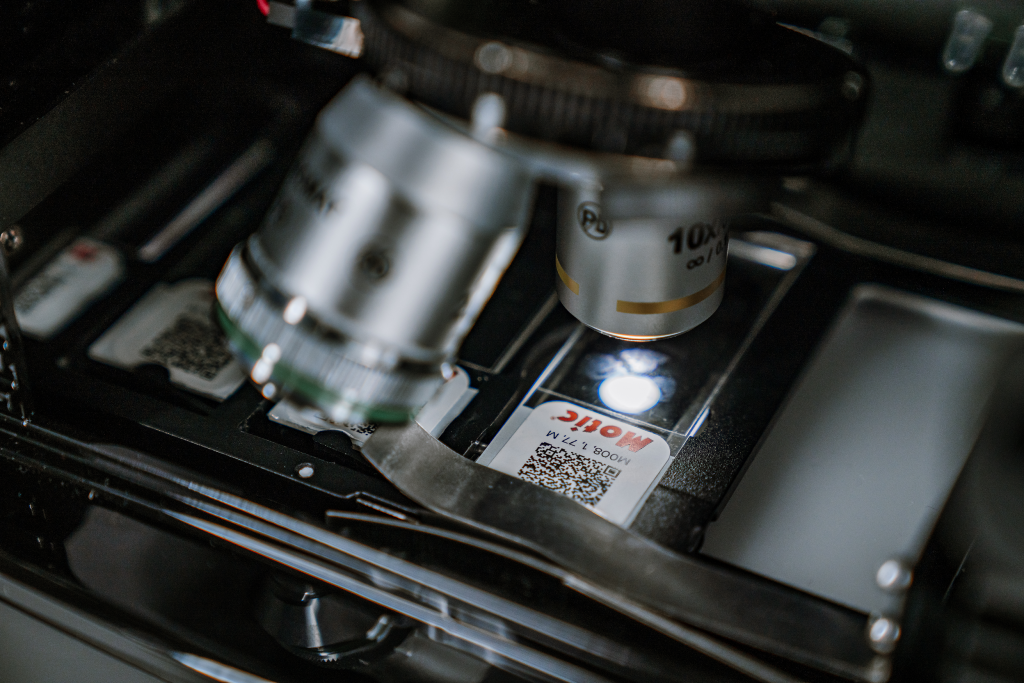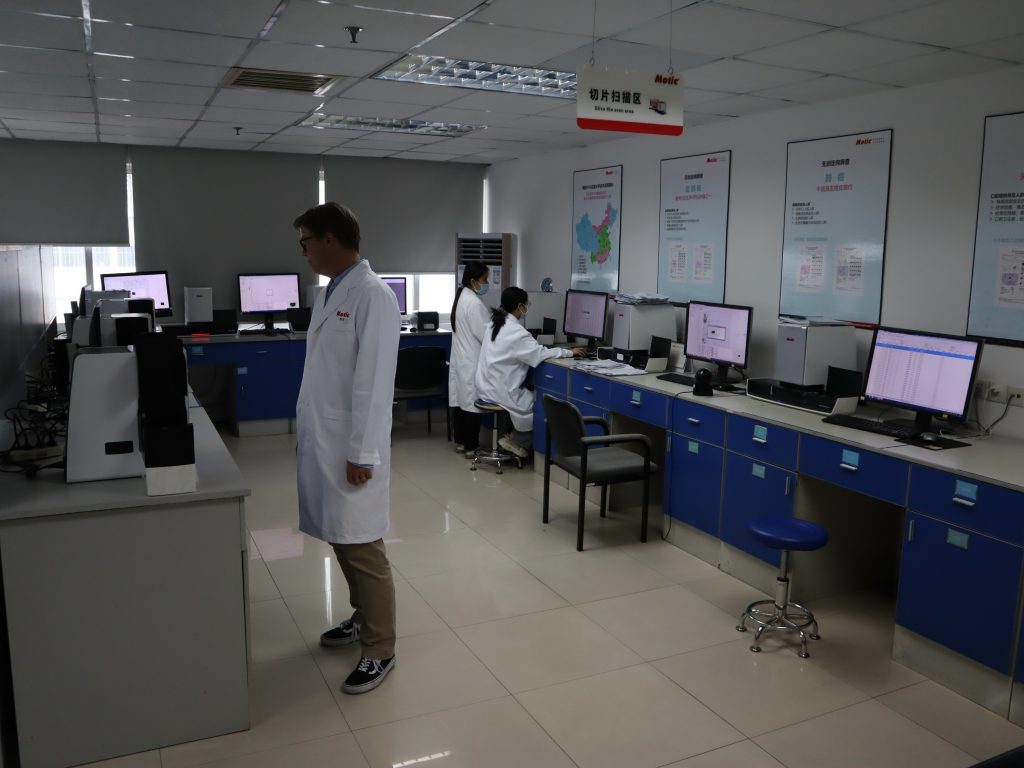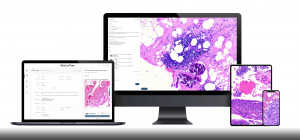
One question that anyone who works in the digital pathology space inevitably encounters is “What are the actual benefits of digital pathology?”. While pathologists and labs have grown increasingly comfortable with the concept of telemedicine and digitizing slide information in the last decade, some skeptics still remain. Meanwhile, for those outside the field, both the idea and the value proposition might be entirely new.
Digital pathology (DP) is a technology that involves the digitization of pathology slides, allowing pathologists to view and analyze them on a computer screen rather than through a microscope. This technology has revolutionized the field of pathology, providing numerous benefits to pathologists, hospitals, and patients alike. In this article, we will explore some of the key benefits of digital pathology, including teleconsultation, standardization in pathology education, remote access to expertise, improved patient outcomes, reduced fatigue/workload for pathologists, and the potential for AI-based disease screening.
Luckily, in many ways, it is quite easy to explain the benefits of using digital pathology because they are so straight-forward and so measurable.
DP is more efficient than a microscope
Digital slides reduce fatigue and render a better image at higher ultimate magnifications than would be available through a microscope alone
Traditional microscopy involves pathologists spending long hours looking through a microscope, which can be physically tiring and can cause eye strain or other issues. With digital pathology, the slides are scanned and digitized, allowing pathologists to view and analyze slides on a computer screen rather than through a microscope eyepiece. This digital platform offers several benefits, including:
Improved accuracy: Digital slides can provide higher-resolution images, with more accurate and consistent color representation, and can be viewed on larger monitors. With powerful annotating, measuring, and screen-capturing tools, you can more asses slides with improved accuracy.
Increased efficiency: With digital pathology, pathologists can quickly and easily access slides from any location, eliminating the need for physical storage and retrieval of slides. Digital pathology also enables remote consultation, allowing pathologists to view and analyze slides from any location in real-time.
Enhanced collaboration: Digital pathology platforms allow pathologists to easily share images and collaborate with other pathologists, clinicians, and researchers around the world. This can lead to more comprehensive collaboration and improve patient outcomes.
Accelerated learning for residents: Digital slides can be easily stored, accessed, and shared, allowing medical students, residents, and pathologists in training to access a wider range of cases and learn from a broader range of experiences. Universities can now send slides to students from anywhere for homework assignments, whereas in the past students only had access to microscopes and slide viewing at their university’s campus.
Overall, digital pathology offers a more efficient, accurate, and collaborative platform for pathology clinical support, research, and education.

Advantages for pathologists
The daily benefits of telepathology translate to a huge quality of life improvement for individual pathologists! Within large hospital systems, pathologists can access their cases directly from their desks or home offices. Virtual slides also allow pathologists to request a second opinion from mentors or field specialists without having to ship slides.
From a pathology workflow perspective, digital slides can reduce fatigue and render a better image at higher magnifications than a microscope alone. Here are the main benefits of digital pathology for pathologists:
- Improved accuracy and speed in diagnosis, resulting in better patient outcomes.
- Reduction in errors due to the ability to review and share cases with colleagues in real-time.
- Increased access to specialist consultations, especially for rural or remote areas.
- Enhanced educational opportunities for pathologists in training through the ability to easily access and share digital slides.
- Cost savings for healthcare institutions due to the elimination of the need for physical slide storage and transportation.
- Improved work-life balance and flexibility for pathologists, particularly those with family or caregiving responsibilities.
- Increased efficiency in pathology workflows, allowing pathologists to see more patients and reduce wait times for results.
- Greater collaboration and knowledge sharing among pathologists across different institutions and geographic locations.
Digital pathology has revolutionized the field of pathology. In the following sections, we will explore the benefits of digital pathology in greater detail and highlight how it is transforming the practice of pathology.
Teleconsultation Platform
Teleconsultation provides relief for the global pathologist provider gap
The use of scanners and cloud-based slide sharing platforms allows healthcare providers in low and middle-income countries to access the knowledge and care resources of high-income countries when diagnosing patients in under-resourced areas. This means that patients in remote or under-resourced areas can receive the same level of care as those in more urban or well-resourced areas, regardless of their location. Moreover, global demographics are shifting such that the United Nations projects up to 68% of the world’s population will live in urban areas by 2050. With these changes, many regions would be left behind entirely if it were not for digital pathology making it possible for clinicians to consult and diagnose remotely.
Additionally, digital pathology allows for remote consultation, enabling pathologists to work together across large distances, which helps to alleviate the shortage of pathologists in certain regions. By enabling teleconsultation, digital pathology is helping to bridge the gap in healthcare resources between different regions of the world.
Education standardization
Digitizing slides allows for unprecedented standardization in pathology education
With digital pathology, medical students and clinicians can access the same slide images from anywhere, at any time, which was previously impossible. This allows for standardization in pathology education, ensuring that all students have access to the same material, regardless of their location or the institution they are studying in. It also allows for greater collaboration between different institutions and regions, improving the sharing of knowledge and expertise.
In summary, digitizing slides allows for unprecedented standardization in pathology education by ensuring that slide images are easily accessible and shareable, regardless of location, and helps to improve collaboration between institutions and regions.
Review virtual slides from anywhere
Benefits of virtual slides in digital pathology
Digital pathology has made it possible to create high-resolution virtual slides, which offer several benefits. One significant advantage is that virtual slides can be viewed and shared easily over the internet, reducing the need for physical transportation of glass slides. This means that pathology experts can view and review slides from anywhere in the world, without having to travel.
Virtual slides also improve access to expertise in pathology. Pathology experts can remotely access and review slide images, enabling them to provide rapid second opinions and consultations. This is especially useful for medical facilities that lack specialized pathology expertise or for patients in remote areas who cannot easily access pathology services.
In summary, the virtual slide capabilities of digital pathology help reduce the need for travel and improve access to expertise in pathology, enabling remote viewing and sharing of slide images from anywhere in the world.
Digital pathology can benefit an entire hospital organization
Digital pathology offers significant benefits for hospitals and healthcare systems, including the ability to expand service reach and provide more specialties without investing in additional physical infrastructure. With virtual slides, hospitals can offer remote consultations and second opinions from pathology experts anywhere in the world, providing patients with access to a wider range of expertise and specialties without requiring them to travel.
Moreover, digital pathology can help to reduce turn-around times and scheduling issues by allowing pathologists and experts to view and review slides more efficiently. This can lead to faster treatment and better outcomes for patients. Additionally, it can reduce the need for scheduling and coordination of in-person consultations, which can be time-consuming and challenging to organize.
Furthermore, digital pathology can help hospitals reduce costs associated with the physical transportation of slides and people, resulting in significant cost savings over time. Ultimately, these benefits lead to better patient outcomes and more efficient workflow processes for healthcare systems.
Benefits of rapid second opinions in digital pathology
Digital pathology allows for the rapid sharing of virtual slides with experts located anywhere, allowing for a second opinion to be obtained quickly. This can help to improve patient outcomes by ensuring that pathologists can make diagnoses accurately and efficiently, reducing the time that patients have to wait for their results and treatment. Additionally, multiple experts can review the same slide and provide their input, leading to a more thorough evaluation and improved accuracy in results.

Global research opportunities
High-throughput WSI slide scanners create enormous data sets needed for machine learning and AI-based pre-screening for diseases, improving global health outcomes
Digital pathology and high-throughput whole slide imaging (WSI) scanners can create enormous data sets that are required for machine learning and the development of artificial intelligence (AI) algorithms. With these data sets, researchers can train algorithms to pre-screen for diseases, including cancer and other conditions.
This technology has the potential to revolutionize healthcare by enabling faster and more accurate diagnoses and treatments, particularly in low and middle-income countries where access to healthcare professionals is limited. This has the potential to improve global health outcomes by reducing the burden of disease, improving patient outcomes, and increasing access to healthcare for underserved populations.
Common issues digital pathology adopters face
Initial costs: Implementing a digital pathology system can be expensive. It requires a significant investment in equipment, software, and staff training.
The primary mission of Motic is to make digital pathology accessible and affordable for any size lab across the globe. Please, check out our buyer’s guide to make it easy for you to take the first steps in the field of digital pathology.
Technical issues: Technical issues such as hardware and software malfunctions can lead to delays in treatment.
Ensure that your vendor has 24-hour customer support so that your operations will never be put on pause. Motic offers 24/7 on-shore customer support so our customers are supported every step in their journey.
Image quality: The quality of digital images in some systems may not always be as good as glass slides, and small details may be missed, leading to inaccuracies in diagnoses.
At Motic, we have over 30+ years of experience in manufacturing our own high-quality objectives that are used in thousands of institutions across the world. Through our extensive experience, we offer best-in-class image quality available globally. If you’re interested in seeing our image quality for yourself, you are welcome to book a demo and receive a free consultation with a Motic expert.
Security and privacy concerns: Digital pathology systems store large amounts of sensitive patient data, which can be vulnerable to cyber-attacks or data breaches. This poses a significant risk to patient privacy and data security.
Your IT department should watch for the proper security of your lab. And provide all necessary support to protect your data from unauthorized access.
Standardization challenges: Standardizing digital pathology practices can be challenging, as there is currently no universal standard for file formats or storage.
That is why MoticEasyScan scanners work with ALL popular formats like SVS and DICOM.
Training and familiarity: Pathologists and other medical professionals may need to undergo training to become familiar with digital pathology systems, which can take time and resources.
Motic Digital Pathology offers on-site and remote training to ensure a seamless transition from your current system to digital pathology. By receiving training from Motic, your team can effectively utilize digital pathology and quickly experience its benefits. Our customer support team will ensure the specific needs and preferences of each organization.
While digital pathology offers significant benefits, it is important to consider the potential challenges that you may face.
Digital pathology offers significant benefits that improve accuracy, patient outcomes, and access to pathology resources. Its potential to revolutionize pathology services globally cannot be overstated, and its adoption should be encouraged for better patient care.
Interested in learning more, book a free demo or consultation with a Motic Expert today!







